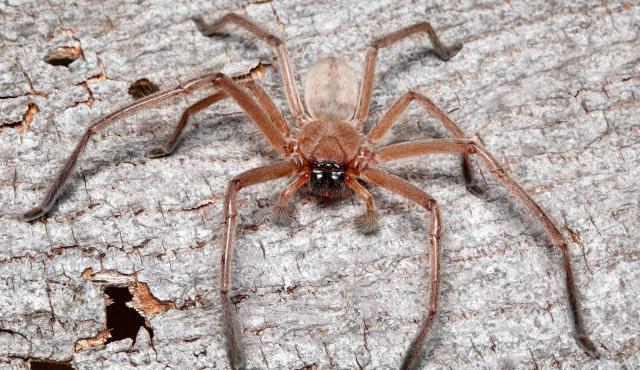A range of teacher professional learning programs will be developed to accompany the Biodiversity of the Western Volcanic Plains online outreach...

Social Huntsman
Delena cancerides
Eggs are held in a flattened circular egg sac made of papery white silk. The spiderlings do not disperse but stay and grow within the colony. They usually live for one or two seasons.
| Details | Description |
| Type | Invertebrate |
| Group | Arachnid - Spider |
| Other Common Names | Flat Huntsman |
| Identifying Characteristics | |
| Distinctive Markings | Large, flat body. Tips of legs dark with front legs longer than the back legs. |
| Diet | Carnivore. Eats insects and other invertebrates. |
| Habitat | Lives in crevices and under the loose bark of trees and within logs. |
| Native Status | Native to Australia |
| Bites/Sting | Huntsman bites have only minor effects including immediate local pain that rarely lasts more than five minutes. Their venom is not thought to be poisonous and the pain is mainly caused by their large fangs. |
| Taxonomy | |
| Phylum | Arthropoda |
| Class | Arachnida |
| Order | Araneae |
| Family | Sparassidae |
| Genus | Delena |
| Species | cancerides |

Distribution maps indicate current and historic locations where species have been sighted.
Source: Atlas of Living Australia
| Conservation Status | |
| DEPI Advisory List | Not listed |
| FFG Act | Not listed |
| EPBC Act | Not listed |
The conservation status of species is listed within Victoria and Australia.
The Department of Environment and Primary Industry (DEPI) Advisory List consists of non-statutory advisory lists of rare or threatened flora and fauna within Victoria.
The Flora and Fauna Guarantee Act 1988 (FFG Act) lists threatened species in Victoria. Under the Act, an Action Statement is produced for each listed species.
The Environment Protection and Biodiversity Conservation Act 1999 (EPBC Act) is the Australian Government’s key piece of environmental legislation, listing nationally threatened native species and ecological communities.



